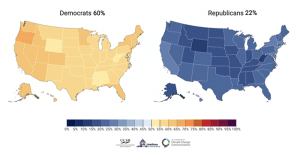Extreme weather no guarantee of support for climate action
By Jennifer Marlon | July 13, 2021
 Badwater Basin in Death Valley, California. In the past few days, temperatures at Death Valley soared to 130 degrees Fahrenheit, matching—or possibly even exceeding—Earth’s highest recorded temperatures in 90 years. Image courtesy of Pixabay
Badwater Basin in Death Valley, California. In the past few days, temperatures at Death Valley soared to 130 degrees Fahrenheit, matching—or possibly even exceeding—Earth’s highest recorded temperatures in 90 years. Image courtesy of Pixabay
Editor’s note: This story was originally published by Yale Climate Connections.
For some Americans, the signs of global warming are everywhere. In 2020 alone, wildfires broke records across the West, hurricanes fueled by abnormally warm ocean temperatures battered the Southeast, and a Death Valley weather station recorded a temperature of 130 degrees Fahrenheit—possibly the hottest daily high ever reliably documented on Earth. Now, drought has taken hold in much of the West, teeing up what is expected to be an extremely active fire season.
Climate scientists have been warning for decades that global warming will lead to more extreme weather. And so as more Americans start to personally experience disastrous weather events, it’s reasonable to ask whether they will support aggressive climate action.
The short answer is already clear: not necessarily.
The signal of climate change is difficult for people to notice against the noisy background of day-to-day and seasonal changes in weather.
But even when a neighborhood, city, or region experiences truly unusual weather, some will see it as clearly connected to global warming—while for others, the connection won’t even occur to them. Just as two people can respond completely differently to political events, current fashions, or to a football game, two individuals can share what seems to be an identical experience and yet come away with completely different conclusions about what happened, what caused it, and what to do about it.
“Experience” is much more slippery than most of us realize. We do not simply use our senses to record information about our surroundings and daily events—we interpret those events and filter them through our emotions, memories, culture, and in the case of weather and climate, our politics. We then combine our beliefs, attitudes, and evaluations of our past experiences to form new opinions, construct new cause-and-effect models in our minds, and ultimately build narratives about events that allow us to make sense of the world and how we fit into it.
The Yale Program on Climate Change Communication, publisher of the Yale Climate Connections site, has been using nationally representative surveys for 12 years to track which Americans think they have personally experienced global warming.
The data shows that Democrats and Republicans living in the same states or counties—or even sharing the same roof—can be a world apart when it comes to perceived experience with global warming (Figure 1). While 60 percent of Democrats nationally say they have personally experienced global warming, only 22 percent of Republicans agree.

Hot, dry days influence perceptions. The strong influence of partisanship on people’s understanding of global warming may not be surprising, but are there some changes in the weather that people are more likely to link with “global warming?” If there are, these weather events are potential conversation starters about climate change.
In a recent study published in the journal Global Environmental Change, my colleagues and I tried to answer this question by combining 12 years of Yale Program on Climate Change Communication survey data with 11 different temperature and precipitation indicators of changing climate conditions over time. Together, the indicators captured long-term temperature and precipitation trends, and also recent extreme heat, rainfall, and snow events between 2008 and 2015.
We found that only one type of weather affected Americans’ beliefs that they had experienced global warming: hot, dry days. When hot, dry days persist for a long period of time, drought conditions arise. In particular, the intense heat and lack of rainfall that affected Texas in the Midwest in 2011, and which turned into a severe drought, stands out clearly in the study’s climate data (Figure 2, top panel). This drought was also associated with extreme wildfires in Texas, which burned about 4 million acres that year, doubling the previous record.

To see the climate influence on people’s experience, we needed to model it. The red and gray maps show the difference between a model that includes the influence of hot, dry days on people’s experience of global warming and one that doesn’t (Figure 2, bottom panel). The red areas indicate where more people said that they had personally experienced global warming in each year. The patterns show that it was not only the 2011 Texas drought that influenced people, but also the droughts in the West in 2008, 2010, and 2014, and in the Midwest in 2012 and 2013. In contrast, the darker gray areas in the Midwest in 2008 and 2010, for example, and along the East Coast in 2012, show that people there were less likely in those years to say they experienced global warming.
The effects of actual weather and climate changes on people’s experience of global warming are still subtle compared with the influence of politics. But as heat, drought, and other severe weather events continue to become more extreme, many of us hope more people will be persuaded to reduce our carbon emissions more aggressively.
People don’t link downpours with global warming. It is encouraging that some people are associating local increases in heat, dryness, and drought with the broader problem of global warming. Extreme heat is the leading weather-related cause of death in the United States, and its increasing occurrence brings greater heat-related risks, like dehydration, heat stroke and exhaustion. Moreover, these effects are disproportionately hurting the most vulnerable among us.
Today, we are breaking heat records at twice the rate as cold records, which before the 1950s had a roughly equal chance of occurring. Drought is the most persistent of extreme weather events, and has devastating effects on agriculture and water supplies, which may explain why people were likely to recall it and link it with climate change.
In our study, people did not link local increases in heavy rainfall with global warming. Given that the connections between global warming and precipitation patterns are more complex than those for temperature alone, perhaps this is not surprising. Yet the relationship is important and has major consequences for our economy and health. Scientists recently calculated that the impact of global warming on Hurricane Sandy includes a price tag of $8 billion from the flooding damage. But many Americans don’t understand how carbon pollution could cause an increase in flooding and hurricane damage. For them, the dots have not been connected yet between cause and effects.
Many are working to connect these dots, showing how climate change is already shaping our lives, and explaining the causal chains between burning fossil fuels, heating the planet, and increasing extreme weather. Kenton Gewecke, chief meteorologist at KOMU 8 in Columbia, Missouri, is just one example. He hosts a series called “Show Me Climate,” in which he talks to scientists and explains how temperatures, rainfall patterns, storms, and other events are changing in Missouri. Gewecke says many viewers appreciate the information. If other broadcast meteorologists follow Gewecke’s lead, they’ll serve as trustworthy and knowledgeable guides to help Americans understand and learn from our experiences.

Together, we make the world safer.
The Bulletin elevates expert voices above the noise. But as an independent nonprofit organization, our operations depend on the support of readers like you. Help us continue to deliver quality journalism that holds leaders accountable. Your support of our work at any level is important. In return, we promise our coverage will be understandable, influential, vigilant, solution-oriented, and fair-minded. Together we can make a difference.
Keywords: climate change, climate crisis, climate perceptions, drought, extreme weather, global warming, heat wave
Topics: Climate Change
















Well yes I see the point of the article and true enough for sure. On the other hand crops stop growing at certain tempertures. We don’t want to wait till then to get people’s attention. It will be too late.